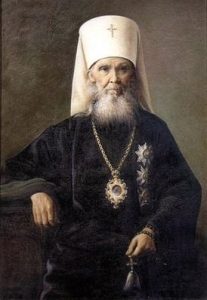Church of St. Macarius (Nevsky), Metropolitan of Moscow and Kolomna, in Butyrskiy

The Church of St. Macarius (Nevsky), Metropolitan of Moscow, Patriarchal compound in Butyrskoe, is located at building 25/20, p. 1, Ogorodny passage, and is named in honor of St. Macarius. St. Macarius, Metropolitan of Moscow and Kolomna, Apostle of Altai (Mikhail Andreevich Parvitsky-Nevsky) was born on October 1, 1835, on the celebration of the Intercession of the Mother of God, in the village of Shapkino, the Vladimir governorate. His father, Andrey Ivanovich, served as a clerk of the village church of the Nativity of the Most Holy Theotokos. Since childhood mother taught little Mikhail to pray. In 1854 he graduated from the seminary (here he was given the surname Nevsky) and, according to his desire to serve the cause of preaching the Gospel, went to the Altai mission as an ordinary employee, although he could have continued his studies at the Academy due to his brilliant successes. A model of missionary service for him was the Venerable Archimandrite Makarii (Glukharyov, May 18), the founder of the Altai mission, about whose life and works he heard from eyewitnesses. At first, the future saint served as a reader, taught at the Catechetical school, accompanied missionaries to remote wild places, studied the Altai language. On March 16, 1861, he took monastic vows with the name Macarius, in honor of St. Macarius the Great. The next day he was ordained a hierodeacon, and on March 19 – a hieromonk. He began his independent missionary service – first in the Chemal camp, and then in Chulyshman. The success of the sermon could only be when the Word of God was brought to the people in their native language. Therefore, Father Makari perfectly mastered the Altai language and its dialects. And for many years he devoted himself to translating liturgical books into the Altai language, working on this in St. Petersburg and Kazan. In 1875, Father Makarii was appointed as assistant chief of the Altai mission. In 1883, Father Makarii was elevated to the rank of bishop of Biysk and he became the head of the Altai mission. Vladyka served in this position for eight years. During this time, the number of baptized increased to 19,216 people (at the time of the founding of the mission under the Venerable Archimandrite Makariya (Glukharev), the number of baptized was 675 people), the number of parish churches up to 49, the same number of schools and colleges with the number of students up to 1,168 people were opened. During the 36 years of his missionary service, Vladyka Makarii gained All-Russian fame. In 1891 he became appointed as Bishop of Tomsk. Vladyka Macarius believed that a pastor should be ready ” to carry out from the treasury of his soul consolation for some, instruction for others, encouragement for others, and reproof for others at any time.” He was also engaged in guardianship: by the end of his stay at the Tomsk department in Tomsk there were eleven parochial guardianships engaged in raising funds for the poor, six orphanages for children, a lodging house, five almshouses. During his ministry, 217 new parishes, two nunneries, 229 parochial schools and 442 parish guardianship offices were opened in the diocese. In May 1906, he was elevated to the rank of archbishop. And in 1912 he was appointed as Metropolitan of Moscow and Kolomna and a member of the Holy Synod. In 1917, after the February coup, a campaign of slander began in the newspapers against Vladyka, who remained faithful to the oath to the sovereign and refused to swear allegiance to the Provisional Government. He was not allowed to attend the All-Russian Council of 1917-1918. The saint was forced to submit his resignation under the threat of imprisonment in the Peter and Paul Fortress. Saint Macarius was exiled to the Nikolo-Ugresh Monastery. He had been in paralysis for the last few years, but had not lost the ability to speak. Patriarch Tikhon visited the sick bishop more than once, their last meeting was in August 1924, both asked each other for forgiveness. The hieromartyr Metropolitan Peter, having become the patriarchal locum tenens, asked the elder for his blessing, and the bishop lovingly presented him with his white hood. The outstanding missionary saint reposed on February 16, 1926 in the village of Kotelniki, the Moscow region, the Lyubertsy district. In 1957, his honest incorruptible remains were transferred to the Trinity-Sergius Lavra and buried in the Church of the Russian Saints of the Assumption Cathedral. He was canonized by the Russian Orthodox Church at the Bishops ‘ Council in August, 2000.
Address: Moscow, Ogorodny ave., vl. 25/20, p. 1

